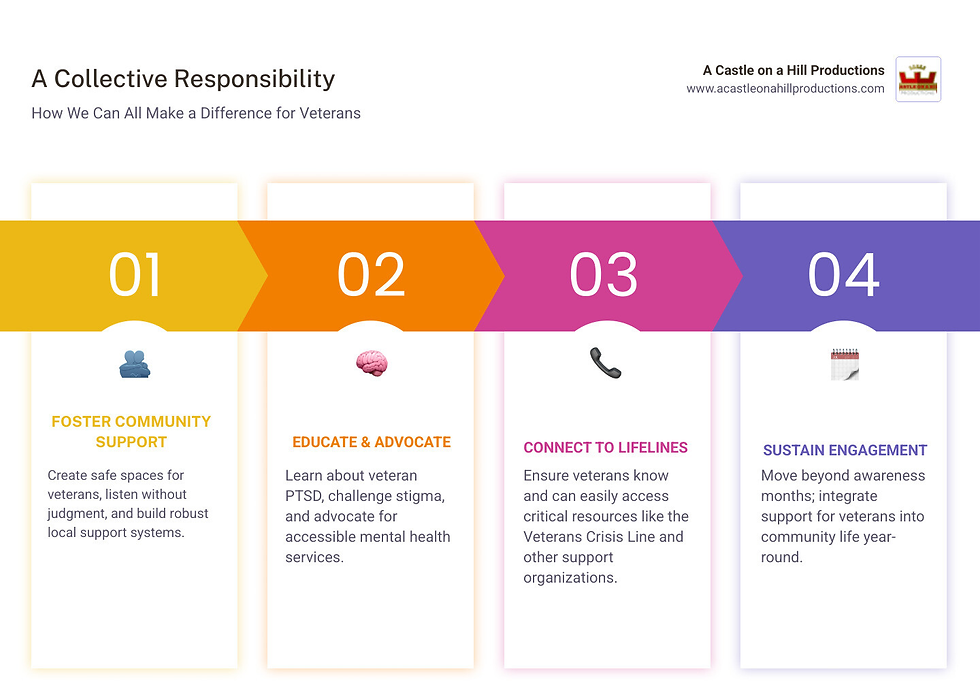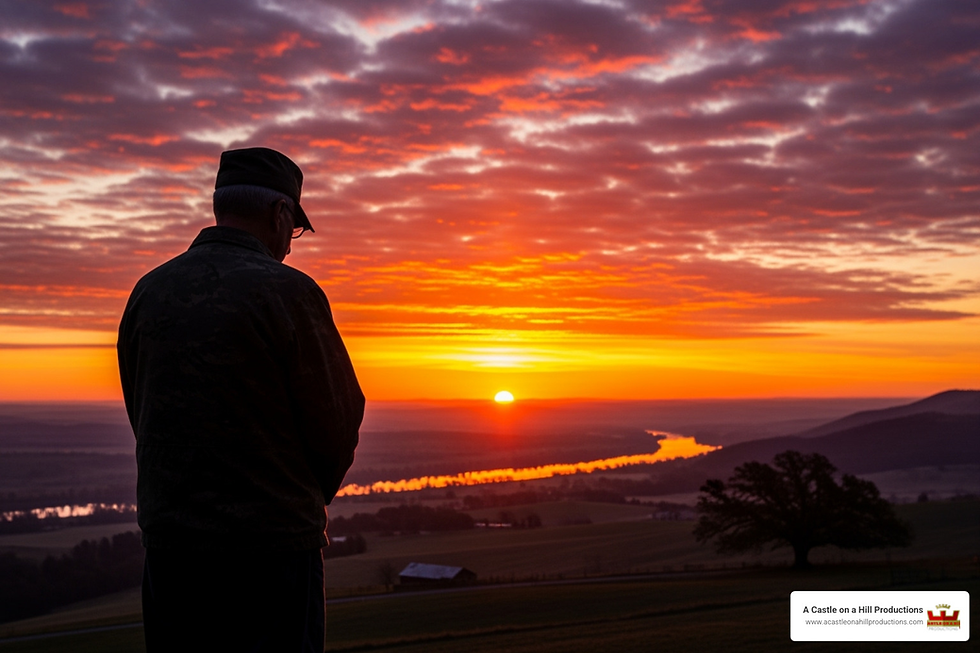From Crisis to Hope: Supporting Our Veterans Through Awareness
- Gary Otte
- Aug 4
- 8 min read
Why Veteran PTSD Awareness Matters More Than Ever

Veteran PTSD awareness is crucial because veterans experience PTSD at significantly higher rates than civilians. Up to 30% of Vietnam veterans, 20% of Iraq and Afghanistan veterans, and 12% of Gulf War veterans are affected by this invisible wound of service.
Key Facts About Veteran PTSD:
30% of service members in war zones experience PTSD.
Only 50% of those affected seek treatment.
Veterans face a significantly higher risk of suicide.
June is PTSD Awareness Month, with June 27th as National PTSD Awareness Day.
Effective treatments exist, but stigma prevents many from seeking help.
The silence surrounding trauma in our veteran community has created a crisis. While we honor visible sacrifices, the psychological wounds often remain invisible and untreated.
As one Navy veteran described it, "PTSD is like a switch that can't always be controlled, leading to hyper-awareness, restlessness, and numbness." This reality affects millions of Americans, their families, and their communities.
June marks PTSD Awareness Month—a critical time to break the silence. While roughly 6% of the general population experiences PTSD, veterans face rates up to five times higher. Yet stigma and other barriers keep many suffering in silence.
As Gary Otte, a cinematographer with over 25 years of experience, I've witnessed how powerful storytelling can transform understanding around veteran PTSD awareness. Through my work, I've learned that raising awareness isn't just about statistics—it's about honoring the human stories behind the numbers.
The Invisible Wounds: Understanding PTSD's Grip on Our Heroes
Post-Traumatic Stress Disorder is a mental health condition that develops after experiencing or witnessing life-threatening trauma. What is PTSD? It's a reality for millions of veterans.
Crucially, PTSD is not a sign of weakness. It's a disorder of survival—the brain's attempt to protect itself after overwhelming trauma. For veterans, battles fought overseas can continue long after they return home, creating a daily struggle in a world that no longer feels safe. Like a physical injury, these invisible wounds need time and treatment to heal. Symptoms can appear months or even years later, making it difficult to connect them to past service.

Recognizing the Signs: Common Symptoms in Veterans
Understanding the warning signs of PTSD is the first step toward getting help. Symptoms fall into four main areas:
Intrusive memories: Unwanted flashbacks, nightmares, or distressing memories that make veterans feel like they are reliving the trauma.
Avoidance behaviors: Actively avoiding people, places, or activities that trigger memories of the trauma, often leading to social isolation.
Negative thoughts and mood changes: Persistent negative beliefs, loss of interest in once-loved activities, emotional numbness, and feelings of detachment.
Hypervigilance and increased reactivity: Being in a constant state of alert, startling easily, having trouble sleeping or concentrating, and experiencing irritability or anger.
When these symptoms persist for more than a month and interfere with daily life, it may indicate PTSD. The four main symptom clusters are: Intrusion, Avoidance, Negative Alterations in Cognitions and Mood, and Alterations in Arousal and Reactivity.
The Ripple Effect: How PTSD Impacts Daily Life, Relationships, and Careers
Veteran PTSD awareness is critical because its effects are far-reaching, touching every aspect of a veteran's life and the lives of those around them.
Family relationships: Emotional numbness and irritability can strain relationships with loved ones. Family members may even develop secondary trauma from the stress.
Workplace challenges: Difficulty with concentration, hypervigilance in office environments, and issues with authority can make steady employment nearly impossible.
Social isolation: Veterans may withdraw from friends and community activities, severing connections that could provide support.
Transition to civilian life: Moving from a structured military environment is already challenging. PTSD can make veterans feel completely lost and misunderstood.
Understanding these effects of PTSD on families shows why awareness isn't just about the individual—it's about supporting entire communities on their healing journey.
The Staggering Reality: Why Veteran PTSD Awareness is a National Imperative
The invisible wounds of trauma have created a public health crisis among our veterans. Veteran PTSD awareness is a national imperative because the numbers tell a story we can no longer ignore. While we've made incredible advances in battlefield medicine, we're still losing too many veterans to the unseen casualties of war.

By the Numbers: The Alarming Statistics of Veteran PTSD
The difference in PTSD rates between veterans and civilians is striking. While about 6% of the general population will experience PTSD, veterans face much higher rates depending on their service era:
Vietnam veterans: 30% have experienced PTSD.
Gulf War veterans: About 12% experience PTSD.
OIF/OEF veterans: Rates range from 11% to 20% in any given year.
Perhaps most troubling, VA data on PTSD prevalence reveals that only half of those affected seek treatment. This underreporting happens for many reasons, including fear of stigma and a belief they should handle it alone.
Beyond the Battlefield: Unseen Causes of Trauma
While combat is a primary cause, PTSD can develop from many military experiences:
Military Sexual Trauma (MST): A serious and hidden cause of trauma, reported by 44.6% of female veterans and 2.9% of male veterans.
Training accidents and witnessing injury: The inherent dangers of military training can leave lasting psychological scars.
Moral injury: Guilt and shame from witnessing or participating in acts that violate one's moral code.
Loss of comrades: The intense bonds formed in service can lead to profound grief and survivor's guilt.
The Ultimate Price: PTSD's Link to Veteran Suicide
The most urgent reason for veteran PTSD awareness is the link between untreated trauma and suicide. Male veterans are 38% more likely to die by suicide than their civilian counterparts, and female veterans are 13% more likely.
PTSD rarely travels alone; it often co-occurs with depression, anxiety, and substance abuse, creating a perfect storm of hopelessness. The danger of Suicidal Ideation becomes very real when veterans feel trapped. This is why crisis intervention and accessible support are life-saving. Every conversation about PTSD awareness has the potential to save a life by showing that seeking help is a sign of strength.
Breaking the Silence: Overcoming Stigma and Barriers to Care
For many veterans, the qualities that made them exceptional in service—strength, self-reliance, and a mission-first mentality—can become barriers to healing. The military ethos of strength runs deep, making it difficult to admit vulnerability. Veterans often fear judgment, negative career impacts, or being seen as "broken" by their families.
Navigating the healthcare system adds another layer of complexity. The VA, while offering crucial services, can feel overwhelming. These barriers, both internal and external, are why destigmatization is essential for saving lives. We must create spaces where seeking help is recognized as an act of courage.

Why Asking for Help is the Hardest Battle
Understanding the barriers to care is key to improving veteran PTSD awareness. Many veterans struggle to ask for help due to:
Cultural Stigma: A deep-seated military culture where mental health challenges are often seen as a weakness.
Self-Reliance Mentality: Training to handle adversity alone makes reaching out feel foreign and uncomfortable.
Lack of Awareness: Not knowing what resources are available or how to access them effectively.
Distrust of the System: Negative past experiences with healthcare can deter future attempts to get help.
Belief No One Can Understand: The feeling that their unique experiences cannot be understood by civilians or even some counselors.
Innovations in Healing: New Approaches to PTSD Treatment
The hopeful truth is that PTSD is treatable, and the landscape of healing is expanding. A combination of proven therapies and innovative approaches offers real hope for recovery.
Evidence-Based Psychotherapies: Therapies like Cognitive Processing Therapy (CPT), Prolonged Exposure (PE) therapy, and Eye Movement Desensitization and Reprocessing (EMDR) are the gold standard for processing trauma.
Talk Therapy and Medication: Therapy addresses the psychological aspects, while medication can help manage physical symptoms like anxiety and sleep disturbances.
Complementary Integrated Health Treatments: Approaches like nutrition support, meditation, yoga, and acupuncture are gaining recognition for supporting mental wellness.
Groundbreaking Research: The VA is exploring innovative treatments like trip-based therapy, using compounds like MDMA and psilocybin in controlled psychotherapeutic settings.
Peer Support Groups: Organizations like the VFW and Wounded Warrior Project provide powerful connections, as healing often happens when a fellow veteran says, "I understand, and you're not alone."
These diverse approaches represent the future of mental wellness for veterans, acknowledging that the path to healing is not one-size-fits-all.
A Collective Responsibility: How We Can All Make a Difference
Veteran PTSD awareness is a collective responsibility. It belongs to all of us—neighbors, coworkers, and friends who want to make a difference. Creating genuine community support starts with listening without judgment and creating safe spaces where veterans feel welcome. PTSD Awareness Month in June, and specifically June 27th, are opportunities to move from awareness to action.

Lifelines of Support: Critical Resources for Veterans
Knowing where to turn can save a life. These lifelines are staffed by people who understand military culture and trauma:
Veterans Crisis Line: The most important resource. Call 988, then Press 1, text 838255, or use the online chat at the Veterans Crisis Line website for 24/7 confidential support.
The National Center for PTSD: A leading research hub offering practical self-help tools for veterans and their families.
Vet Centers: Community-based centers providing free, confidential counseling in a more relaxed setting than traditional VA hospitals.
Wounded Warrior Project: An ecosystem of support that connects veterans with peers and offers programs to help them thrive.
Your Role in Their Recovery: A Guide for Friends, Family, and Community
Everyone in a veteran's life can be part of their healing journey. Here’s how you can help:
Educate yourself: Understand the symptoms of PTSD to respond with compassion. The VA's Help for friends and families page is a great start.
Listen without judgment: Be present and listen. You don't need to have the answers.
Offer practical help: Assist with errands or childcare to remove barriers to treatment.
Encourage professional treatment: Gently suggest they speak to a professional, framing it as a sign of strength.
Practice patience and empathy: Healing isn't linear. Your consistent presence is a powerful support.
Find support for yourself: Supporting someone with PTSD is demanding. Take care of your own mental health.
More Than a Month: The Enduring Importance of Veteran PTSD Awareness
Veteran PTSD awareness must be a year-round commitment. Real change happens when we weave support for veterans into the fabric of our communities. This means sustaining conversations about mental health, creating veteran-friendly workplaces, and advocating for better funding and access to care. Honoring their sacrifice means ensuring they receive the understanding, care, and hope they've earned, so no veteran has to face their invisible wounds alone.
Conclusion
The journey from crisis to hope is a promise we must fulfill for veterans with PTSD. We've seen the reality of their invisible wounds and the stark statistics, but we've also seen that a path to healing exists. Supported by effective treatments and compassionate communities, breaking the silence can transform despair into recovery.
As a storyteller, I've learned that powerful narratives change hearts and minds. At A Castle on a Hill Productions, we are committed to bringing veteran experiences to light, inspiring action and building the empathy our heroes need.
Veteran PTSD awareness requires a year-round commitment from all of us, whether in Billings, Kansas City, Dallas, Colorado Springs, Montana, or anywhere across the nation. Every conversation and act of support contributes to a culture where seeking help is seen as courage.
Our veterans showed bravery in their service. It is our turn to show courage by listening, learning, and acting. Let's unite to support these heroes with a sustained commitment to their well-being, ensuring no veteran faces the battle against PTSD alone.
To see how we're bringing these vital stories to life, we invite you to Learn more about the "Saving 22" documentary.




Comments